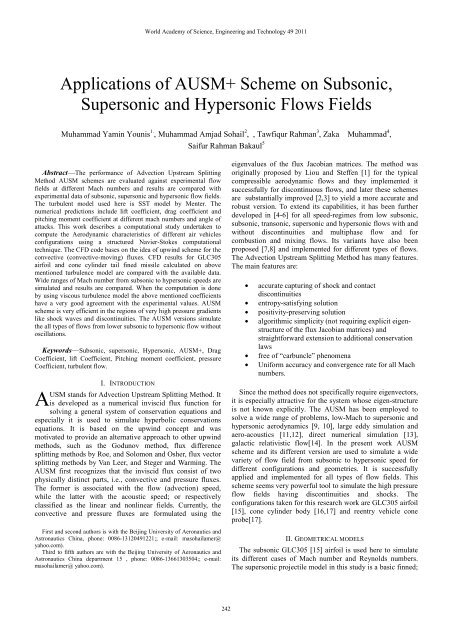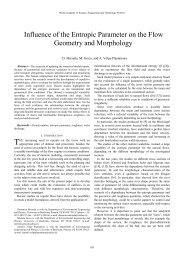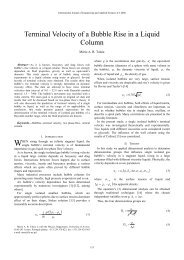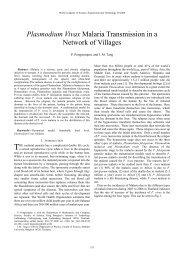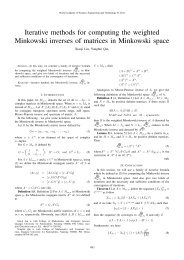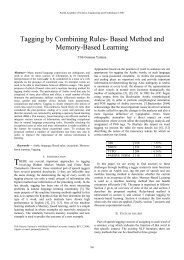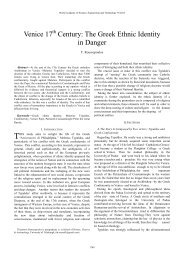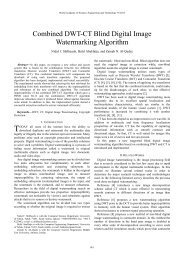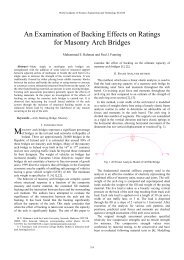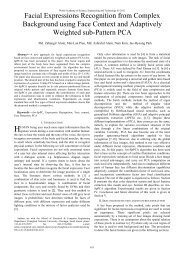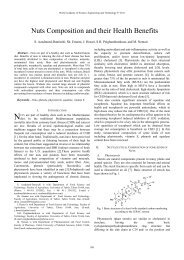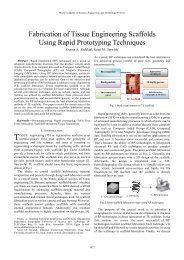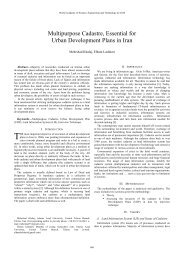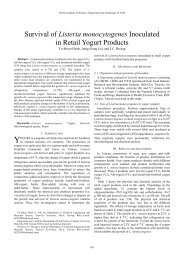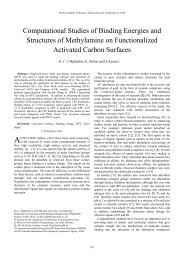Applications of AUSM+ Scheme on Subsonic, Supersonic and ...
Applications of AUSM+ Scheme on Subsonic, Supersonic and ...
Applications of AUSM+ Scheme on Subsonic, Supersonic and ...
Create successful ePaper yourself
Turn your PDF publications into a flip-book with our unique Google optimized e-Paper software.
Abstract—The performance <str<strong>on</strong>g>of</str<strong>on</strong>g> Advecti<strong>on</strong> Upstream Splitting<br />
Method AUSM schemes are evaluated against experimental flow<br />
fields at different Mach numbers <strong>and</strong> results are compared with<br />
experimental data <str<strong>on</strong>g>of</str<strong>on</strong>g> subs<strong>on</strong>ic, supers<strong>on</strong>ic <strong>and</strong> hypers<strong>on</strong>ic flow fields.<br />
The turbulent model used here is SST model by Menter. The<br />
numerical predicti<strong>on</strong>s include lift coefficient, drag coefficient <strong>and</strong><br />
pitching moment coefficient at different mach numbers <strong>and</strong> angle <str<strong>on</strong>g>of</str<strong>on</strong>g><br />
attacks. This work describes a computati<strong>on</strong>al study undertaken to<br />
compute the Aerodynamic characteristics <str<strong>on</strong>g>of</str<strong>on</strong>g> different air vehicles<br />
c<strong>on</strong>figurati<strong>on</strong>s using a structured Navier-Stokes computati<strong>on</strong>al<br />
technique. The CFD code bases <strong>on</strong> the idea <str<strong>on</strong>g>of</str<strong>on</strong>g> upwind scheme for the<br />
c<strong>on</strong>vective (c<strong>on</strong>vective-moving) fluxes. CFD results for GLC305<br />
airfoil <strong>and</strong> c<strong>on</strong>e cylinder tail fined missile calculated <strong>on</strong> above<br />
menti<strong>on</strong>ed turbulence model are compared with the available data.<br />
Wide ranges <str<strong>on</strong>g>of</str<strong>on</strong>g> Mach number from subs<strong>on</strong>ic to hypers<strong>on</strong>ic speeds are<br />
simulated <strong>and</strong> results are compared. When the computati<strong>on</strong> is d<strong>on</strong>e<br />
by using viscous turbulence model the above menti<strong>on</strong>ed coefficients<br />
have a very good agreement with the experimental values. AUSM<br />
scheme is very efficient in the regi<strong>on</strong>s <str<strong>on</strong>g>of</str<strong>on</strong>g> very high pressure gradients<br />
like shock waves <strong>and</strong> disc<strong>on</strong>tinuities. The AUSM versi<strong>on</strong>s simulate<br />
the all types <str<strong>on</strong>g>of</str<strong>on</strong>g> flows from lower subs<strong>on</strong>ic to hypers<strong>on</strong>ic flow without<br />
oscillati<strong>on</strong>s.<br />
Keywords—Subs<strong>on</strong>ic, supers<strong>on</strong>ic, Hypers<strong>on</strong>ic, <str<strong>on</strong>g>AUSM+</str<strong>on</strong>g>, Drag<br />
Coefficient, lift Coefficient, Pitching moment coefficient, pressure<br />
Coefficient, turbulent flow.<br />
A<br />
I. INTRODUCTION<br />
USM st<strong>and</strong>s for Advecti<strong>on</strong> Upstream Splitting Method. It<br />
is developed as a numerical inviscid flux functi<strong>on</strong> for<br />
solving a general system <str<strong>on</strong>g>of</str<strong>on</strong>g> c<strong>on</strong>servati<strong>on</strong> equati<strong>on</strong>s <strong>and</strong><br />
especially it is used to simulate hyperbolic c<strong>on</strong>servati<strong>on</strong>s<br />
equati<strong>on</strong>s. It is based <strong>on</strong> the upwind c<strong>on</strong>cept <strong>and</strong> was<br />
motivated to provide an alternative approach to other upwind<br />
methods, such as the Godunov method, flux difference<br />
splitting methods by Roe, <strong>and</strong> Solom<strong>on</strong> <strong>and</strong> Osher, flux vector<br />
splitting methods by Van Leer, <strong>and</strong> Steger <strong>and</strong> Warming. The<br />
AUSM first recognizes that the inviscid flux c<strong>on</strong>sist <str<strong>on</strong>g>of</str<strong>on</strong>g> two<br />
physically distinct parts, i.e., c<strong>on</strong>vective <strong>and</strong> pressure fluxes.<br />
The former is associated with the flow (advecti<strong>on</strong>) speed,<br />
while the latter with the acoustic speed; or respectively<br />
classified as the linear <strong>and</strong> n<strong>on</strong>linear fields. Currently, the<br />
c<strong>on</strong>vective <strong>and</strong> pressure fluxes are formulated using the<br />
First <strong>and</strong> sec<strong>on</strong>d authors is with the Beijing University <str<strong>on</strong>g>of</str<strong>on</strong>g> Aer<strong>on</strong>autics <strong>and</strong><br />
Astr<strong>on</strong>autics China, ph<strong>on</strong>e: 0086-13120491221;; e-mail: masohailamer@<br />
yahoo.com).<br />
Third to fifth authors are with the Beijing University <str<strong>on</strong>g>of</str<strong>on</strong>g> Aer<strong>on</strong>autics <strong>and</strong><br />
Astr<strong>on</strong>autics China department 15 , ph<strong>on</strong>e: 0086-13661303504;; e-mail:<br />
masohailamer@ yahoo.com).<br />
World Academy <str<strong>on</strong>g>of</str<strong>on</strong>g> Science, Engineering <strong>and</strong> Technology 49 2011<br />
<str<strong>on</strong>g>Applicati<strong>on</strong>s</str<strong>on</strong>g> <str<strong>on</strong>g>of</str<strong>on</strong>g> <str<strong>on</strong>g>AUSM+</str<strong>on</strong>g> <str<strong>on</strong>g>Scheme</str<strong>on</strong>g> <strong>on</strong> Subs<strong>on</strong>ic,<br />
Supers<strong>on</strong>ic <strong>and</strong> Hypers<strong>on</strong>ic Flows Fields<br />
Muhammad Yamin Younis 1. , Muhammad Amjad Sohail 2 , , Tawfiqur Rahman 3 , Zaka Muhammad 4 ,<br />
Saifur Rahman Bakaul 5<br />
242<br />
eigenvalues <str<strong>on</strong>g>of</str<strong>on</strong>g> the flux Jacobian matrices. The method was<br />
originally proposed by Liou <strong>and</strong> Steffen [1] for the typical<br />
compressible aerodynamic flows <strong>and</strong> they implemented it<br />
successfully for disc<strong>on</strong>tinuous flows, <strong>and</strong> later these schemes<br />
are substantially improved [2,3] to yield a more accurate <strong>and</strong><br />
robust versi<strong>on</strong>. To extend its capabilities, it has been further<br />
developed in [4-6] for all speed-regimes from low subs<strong>on</strong>ic,<br />
subs<strong>on</strong>ic, trans<strong>on</strong>ic, supers<strong>on</strong>ic <strong>and</strong> hypers<strong>on</strong>ic flows with <strong>and</strong><br />
without disc<strong>on</strong>tinuities <strong>and</strong> multiphase flow <strong>and</strong> for<br />
combusti<strong>on</strong> <strong>and</strong> mixing flows. Its variants have also been<br />
proposed [7,8] <strong>and</strong> implemented for different types <str<strong>on</strong>g>of</str<strong>on</strong>g> flows.<br />
The Advecti<strong>on</strong> Upstream Splitting Method has many features.<br />
The main features are:<br />
• accurate capturing <str<strong>on</strong>g>of</str<strong>on</strong>g> shock <strong>and</strong> c<strong>on</strong>tact<br />
disc<strong>on</strong>tinuities<br />
• entropy-satisfying soluti<strong>on</strong><br />
• positivity-preserving soluti<strong>on</strong><br />
• algorithmic simplicity (not requiring explicit eigenstructure<br />
<str<strong>on</strong>g>of</str<strong>on</strong>g> the flux Jacobian matrices) <strong>and</strong><br />
straightforward extensi<strong>on</strong> to additi<strong>on</strong>al c<strong>on</strong>servati<strong>on</strong><br />
laws<br />
• free <str<strong>on</strong>g>of</str<strong>on</strong>g> “carbuncle” phenomena<br />
• Uniform accuracy <strong>and</strong> c<strong>on</strong>vergence rate for all Mach<br />
numbers.<br />
Since the method does not specifically require eigenvectors,<br />
it is especially attractive for the system whose eigen-structure<br />
is not known explicitly. The AUSM has been employed to<br />
solve a wide range <str<strong>on</strong>g>of</str<strong>on</strong>g> problems, low-Mach to supers<strong>on</strong>ic <strong>and</strong><br />
hypers<strong>on</strong>ic aerodynamics [9, 10], large eddy simulati<strong>on</strong> <strong>and</strong><br />
aero-acoustics [11,12], direct numerical simulati<strong>on</strong> [13],<br />
galactic relativistic flow[14]. In the present work AUSM<br />
scheme <strong>and</strong> its different versi<strong>on</strong> are used to simulate a wide<br />
variety <str<strong>on</strong>g>of</str<strong>on</strong>g> flow field from subs<strong>on</strong>ic to hypers<strong>on</strong>ic speed for<br />
different c<strong>on</strong>figurati<strong>on</strong>s <strong>and</strong> geometries. It is successfully<br />
applied <strong>and</strong> implemented for all types <str<strong>on</strong>g>of</str<strong>on</strong>g> flow fields. This<br />
scheme seems very powerful tool to simulate the high pressure<br />
flow fields having disc<strong>on</strong>tinuities <strong>and</strong> shocks. The<br />
c<strong>on</strong>figurati<strong>on</strong>s taken for this research work are GLC305 airfoil<br />
[15], c<strong>on</strong>e cylinder body [16,17] <strong>and</strong> reentry vehicle c<strong>on</strong>e<br />
probe[17].<br />
II. GEOMETRICAL MODELS<br />
The subs<strong>on</strong>ic GLC305 [15] airfoil is used here to simulate<br />
its different cases <str<strong>on</strong>g>of</str<strong>on</strong>g> Mach number <strong>and</strong> Reynolds numbers.<br />
The supers<strong>on</strong>ic projectile model in this study is a basic finned;
a c<strong>on</strong>e-cylinder-finned c<strong>on</strong>figurati<strong>on</strong> <strong>and</strong> c<strong>on</strong>e cylinder body<br />
(see Figure1). The length <str<strong>on</strong>g>of</str<strong>on</strong>g> the projectile without fins is 6<br />
calibers <strong>and</strong> the diameter is 40 mm. the length <str<strong>on</strong>g>of</str<strong>on</strong>g> fined body is<br />
10 calibers <strong>and</strong> diameter is 30 mm. Four fins are located <strong>on</strong><br />
the back end <str<strong>on</strong>g>of</str<strong>on</strong>g> the projectile. All necessary details <str<strong>on</strong>g>of</str<strong>on</strong>g><br />
geometries are given in reference [16,17] . A hypers<strong>on</strong>ic<br />
reentry c<strong>on</strong>e probe [18] is simulated at mach 5.9 <strong>and</strong> its tip to<br />
base radius ratios is changed from 0,0.25 <strong>and</strong> 0.50 <strong>and</strong> angle<br />
<str<strong>on</strong>g>of</str<strong>on</strong>g> c<strong>on</strong>e is taken 30 o . A structured computati<strong>on</strong>al mesh was<br />
generated for these c<strong>on</strong>figurati<strong>on</strong>s. In general, most <str<strong>on</strong>g>of</str<strong>on</strong>g> the grid<br />
points are clustered in the near wall regi<strong>on</strong> to capture the<br />
boundary layer <strong>and</strong> c<strong>on</strong>trol the Y + value for turbulence model.<br />
.<br />
(a)<br />
(b)<br />
(c)<br />
(d)<br />
Fig. 1 (a) airfoil (b)(c) c<strong>on</strong>e cylinder with <strong>and</strong> without fins (d) c<strong>on</strong>e<br />
III. GOVERNING EQUATIONS AND NUMERICAL<br />
METHOD<br />
The system <str<strong>on</strong>g>of</str<strong>on</strong>g> governing equati<strong>on</strong>s for a single-comp<strong>on</strong>ent<br />
fluid, written to describe the mean flow properties, is cast in<br />
integral Cartesian form for an arbitrary c<strong>on</strong>trol volume V with<br />
differential surface area dA as follows:<br />
World Academy <str<strong>on</strong>g>of</str<strong>on</strong>g> Science, Engineering <strong>and</strong> Technology 49 2011<br />
243<br />
∂<br />
∂t<br />
∫<br />
V<br />
WdV +<br />
∫[<br />
F −G]<br />
dA = ∫<br />
. HdV (1)<br />
Where the vectors W, F <strong>and</strong> G are defined as:<br />
⎡ρ<br />
⎤ ⎡ρu<br />
⎤<br />
⎧0<br />
⎫<br />
⎢ ⎥ ⎢ ⎥<br />
⎪ ⎪<br />
⎢<br />
ρu<br />
⎥ ⎢ρvu+<br />
Piˆ<br />
⎥<br />
⎪<br />
τ xi ⎪<br />
W = ⎢ρv<br />
⎥ , ⎢ ⎥<br />
⎪ ⎪<br />
F = ρvv+<br />
Pˆj<br />
, G =<br />
⎢ ⎥ ⎢ ⎥<br />
⎨τ<br />
yi ⎬<br />
⎢ρw⎥<br />
⎢ρvw+<br />
Pkˆ<br />
⎥<br />
⎪ ⎪<br />
⎢<br />
⎣ρE⎥<br />
⎢ ⎥<br />
⎪<br />
τ Zi ⎪<br />
⎦ ⎢⎣<br />
ρvE+<br />
Pv⎥<br />
⎪ ⎪<br />
⎦ τ ijv<br />
j + q<br />
⎪⎩<br />
⎪⎭<br />
Vector H c<strong>on</strong>tains source terms such as body forces <strong>and</strong><br />
energy sources.<br />
Here ρ, v, E, <strong>and</strong> p are the density, velocity, total energy<br />
per unit mass, <strong>and</strong> pressure <str<strong>on</strong>g>of</str<strong>on</strong>g> the fluid, respectively.Τ is<br />
the viscous stress tensor, <strong>and</strong> q is the heat flux.<br />
Total energy E is related to the total enthalpy H by<br />
E=H-p/ρ<br />
Where<br />
H=h+׀v׀ 2 /2<br />
IV. NUMERICAL METHODS<br />
4.1 Advecti<strong>on</strong> Upstream Splitting Method<br />
The Advecti<strong>on</strong> Upstream Splitting Method (AUSM)<br />
scheme was introduced <strong>and</strong> applied by Liou <strong>and</strong> Steffen<br />
in1991 [1-3] .The AUSM scheme defines a cell interface Mach<br />
number based <strong>on</strong> characteristic speeds from the neighboring<br />
cells. The interface Mach number is used to determine the<br />
upwind extrapolati<strong>on</strong> for the c<strong>on</strong>vective part <str<strong>on</strong>g>of</str<strong>on</strong>g> the inviscid<br />
fluxes. A separate splitting is used for the pressure terms.<br />
Generalized Mach number <strong>and</strong> pressure splitting functi<strong>on</strong>s are<br />
described by Liou [1,2,4] <strong>and</strong> the new scheme was termed<br />
ASUM+. The <str<strong>on</strong>g>AUSM+</str<strong>on</strong>g> scheme was shown to have several<br />
desirable properties:<br />
1. It gives exact resoluti<strong>on</strong> <str<strong>on</strong>g>of</str<strong>on</strong>g> 1-D c<strong>on</strong>tact <strong>and</strong> shock<br />
disc<strong>on</strong>tinuities,<br />
2. It preserves positivity <str<strong>on</strong>g>of</str<strong>on</strong>g> scalar quantities,<br />
3. It is free <str<strong>on</strong>g>of</str<strong>on</strong>g> oscillati<strong>on</strong>s at stati<strong>on</strong>ary <strong>and</strong> moving shocks.<br />
The <str<strong>on</strong>g>AUSM+</str<strong>on</strong>g> scheme avoids an explicit artificial dissipati<strong>on</strong>,<br />
<strong>and</strong> differences the fluxes directly using:<br />
∂ E = Ei<br />
− Ei<br />
ξ<br />
V<br />
+ 1/ 2 −1/<br />
2<br />
The algebraic method is used to generate three-dimensi<strong>on</strong>al<br />
boundary-fitted grids for a c<strong>on</strong>e. The height <str<strong>on</strong>g>of</str<strong>on</strong>g> the first grid<br />
next to the body is c<strong>on</strong>trolled, <strong>and</strong> the grids near to the body<br />
are normalized. The C-type mesh is generated <strong>on</strong> the tip <str<strong>on</strong>g>of</str<strong>on</strong>g> the<br />
c<strong>on</strong>e. The grid size is 70x50x36 is used for this geometry.<br />
V. TURBULENCE MODEL<br />
The K-ω SST model [19,20] (Menter, 1993) is a two equati<strong>on</strong><br />
model that solves the transport <str<strong>on</strong>g>of</str<strong>on</strong>g> specific dissipati<strong>on</strong> rate <str<strong>on</strong>g>of</str<strong>on</strong>g><br />
turbulent kinetic energy <strong>and</strong> the turbulent kinetic energy. This<br />
model is a combinati<strong>on</strong> <str<strong>on</strong>g>of</str<strong>on</strong>g> the k-ω <strong>and</strong> k-ε models.
∂<br />
∂t<br />
∂<br />
∂x<br />
( k)<br />
+ ( ρu<br />
k)<br />
= p−C<br />
ρωk<br />
+ ( μ+<br />
σ μ )<br />
∂<br />
∂t<br />
ρ j<br />
μ<br />
j<br />
∂<br />
( ρω)<br />
+ ( ρu<br />
ω)<br />
∂ ⎡<br />
⎢<br />
∂x<br />
j ⎢⎣<br />
∂x<br />
j<br />
( μ + σ μ ) + ( − F )<br />
ω t<br />
j<br />
∂ω<br />
⎤<br />
⎥<br />
∂x<br />
j ⎥⎦<br />
∂ ⎡<br />
⎢<br />
∂xj<br />
⎢⎣<br />
γρ<br />
2<br />
= p − βρω +<br />
μ<br />
t<br />
1 1 2ρσω2<br />
k<br />
t<br />
ω ∂x<br />
∂k<br />
⎤<br />
⎥<br />
∂xj<br />
⎥⎦<br />
1 ∂k<br />
∂ω<br />
j<br />
∂x<br />
A. 3.4 Steady-State Flow Soluti<strong>on</strong> Methods<br />
The coupled set <str<strong>on</strong>g>of</str<strong>on</strong>g> governing equati<strong>on</strong>s is discretized in<br />
time for steady calculati<strong>on</strong>s. In the steady case, it is assumed<br />
that time marching proceeds until a steady-state soluti<strong>on</strong> is<br />
reached. Temporal Discretizati<strong>on</strong> <str<strong>on</strong>g>of</str<strong>on</strong>g> the coupled equati<strong>on</strong>s is<br />
accomplished by an explicit time-marching algorithm.<br />
3.5 Explicit Formulati<strong>on</strong><br />
A density based explicit formulati<strong>on</strong> is used for these<br />
computati<strong>on</strong>s. In the explicit scheme a multi-stage, timestepping<br />
algorithm [21] is used to discritize the time derivative<br />
in Equati<strong>on</strong> 1. The soluti<strong>on</strong> is advanced from iterati<strong>on</strong> n to<br />
iterati<strong>on</strong> n+1 with an m-stage Runge-Kutta scheme given by<br />
Q 0 =Q n<br />
i<br />
ΔQ<br />
= −α<br />
ΔtΓ<br />
n+1<br />
Q =<br />
Q<br />
m<br />
i<br />
R<br />
−1<br />
i−1<br />
VI. RESULTS AND DISCUSSION<br />
4 Results <strong>and</strong> Discussi<strong>on</strong><br />
In the figures 2-5 airfoil GLC305 pressure, density <strong>and</strong><br />
velocity distributi<strong>on</strong>s c<strong>on</strong>tours are shown. The comparis<strong>on</strong> <str<strong>on</strong>g>of</str<strong>on</strong>g><br />
different aerodynamics characteristics against angle <str<strong>on</strong>g>of</str<strong>on</strong>g> attack<br />
for different Mach number is graphed.<br />
World Academy <str<strong>on</strong>g>of</str<strong>on</strong>g> Science, Engineering <strong>and</strong> Technology 49 2011<br />
j<br />
(2)<br />
(3)<br />
(4)<br />
244<br />
Fig. 2 (a) Pressure <strong>and</strong> density distributi<strong>on</strong> <strong>on</strong> clean GLC305 at<br />
AoA = 8 ◦ M = 0.12, Re = 3x10 6<br />
Fig. 2 (b)Velocity distributi<strong>on</strong> <strong>on</strong> clean GLC305 at AoA = 8 ◦ M =<br />
0.12, Re = 3x10 6<br />
0.020<br />
0.018<br />
0.016<br />
0.014<br />
0.012<br />
Cd0.010<br />
0.008<br />
0.006<br />
0.004<br />
0.002<br />
0.000<br />
Re = 3x10 6<br />
Numerical M=0.12<br />
Experimental M=0.12<br />
Numerical M=0.21<br />
Experimental M=0.21<br />
Numerical M=0.28<br />
Experimental M=0.28<br />
0 2 4 6 8<br />
α (deg)<br />
10 12 14<br />
Fig. 3 Lift coefficient vs AoA for clean GLC305 airfoil
1.6<br />
1.4<br />
1.2<br />
1.0<br />
Cl 0.8<br />
0.6<br />
0.4<br />
0.2<br />
0.0<br />
0 2 4 6 8 10 12 14<br />
α (deg)<br />
Fig. 4 Drag coefficient vs AoA for clean GLC305 airfoil<br />
From figures 6 to 9 c<strong>on</strong>e cylinder <strong>and</strong> c<strong>on</strong>e cylinder with<br />
fins c<strong>on</strong>tours <strong>and</strong> graphs are plotted. The c<strong>on</strong>e cylinder body<br />
c<strong>on</strong>figurati<strong>on</strong>s are simulated <strong>and</strong> mach 4 other test c<strong>on</strong>diti<strong>on</strong>s<br />
are given in ref.16 <strong>and</strong> the finned missile [17] is simulated at<br />
different Mach number as shown in the graph. The results for<br />
AUSM scheme have a satisfactory agreement with the<br />
experimental <strong>and</strong> Roe scheme <strong>and</strong> other available data.<br />
0.025<br />
0.020<br />
0.015<br />
0.010<br />
Cm<br />
0.005<br />
0.000<br />
-0.005<br />
-0.010<br />
Re = 3x10 6<br />
Numerical M=0.12<br />
Experimental M=0.12<br />
Numerical M=0.21<br />
Experimental M=0.21<br />
Numerical M=0.28<br />
Experimental M=0.28<br />
0 2 4 6 8 10 12 14<br />
α (deg)<br />
Fig. 5 Pitching moment coefficient vs AoA for clean GLC305 airfoil<br />
at different Mach number<br />
World Academy <str<strong>on</strong>g>of</str<strong>on</strong>g> Science, Engineering <strong>and</strong> Technology 49 2011<br />
Numerical<br />
M=0.12<br />
M=0.21<br />
M=0.28<br />
245<br />
Fig. 6 Mach number c<strong>on</strong>tours for c<strong>on</strong>e cylinder at mach 4 angle <str<strong>on</strong>g>of</str<strong>on</strong>g><br />
attack 4 o<br />
Fig. 7 C<strong>on</strong>tours <str<strong>on</strong>g>of</str<strong>on</strong>g> Mach number <strong>and</strong> pressure for AUSM scheme at<br />
angle <str<strong>on</strong>g>of</str<strong>on</strong>g> attack 1 o .
Fig. 8 Drag coefficient <str<strong>on</strong>g>of</str<strong>on</strong>g> fined missile at zero <strong>and</strong> 1 o angle <str<strong>on</strong>g>of</str<strong>on</strong>g> attack.<br />
Fig. 9 Drag, lift <strong>and</strong> pitching moment coefficient <str<strong>on</strong>g>of</str<strong>on</strong>g> c<strong>on</strong>e cylinder<br />
body against angle <str<strong>on</strong>g>of</str<strong>on</strong>g> attack.<br />
From figure 10 to 15 c<strong>on</strong>tours <str<strong>on</strong>g>of</str<strong>on</strong>g> temperature, pressure,<br />
World Academy <str<strong>on</strong>g>of</str<strong>on</strong>g> Science, Engineering <strong>and</strong> Technology 49 2011<br />
246<br />
Mach number <strong>and</strong> density are shown for different c<strong>on</strong>e probe<br />
c<strong>on</strong>figurati<strong>on</strong>s. Shock waves are captured by this scheme very<br />
accurately as shown in figure. The results for drag lift <strong>and</strong><br />
pitching moment coefficients have a very good agreement<br />
with the experimental results. esults. For this hypers<strong>on</strong>ic flow shock<br />
waves is captured by the AUSM scheme <strong>and</strong> the soluble is<br />
stable <strong>and</strong> got higher order accuracy by using limiters.<br />
Fig. 10 C<strong>on</strong>tours <str<strong>on</strong>g>of</str<strong>on</strong>g> temperature, pressure, mach no., <strong>and</strong> density at<br />
Mach 5.9,rn/rb= = 0.5 <strong>and</strong> angle <str<strong>on</strong>g>of</str<strong>on</strong>g> attack 12 o<br />
Fig. 11 C<strong>on</strong>tours <str<strong>on</strong>g>of</str<strong>on</strong>g> Temperature, pressure, Mach no. <strong>and</strong> density at<br />
θ=30 o ,rn/rb=0.25 =0.25 <strong>and</strong> angle <str<strong>on</strong>g>of</str<strong>on</strong>g> attack -4 o
Fig. 13 Graph for Drag coeff. , lift <strong>and</strong> Pitching moment<br />
Coefficient for r n/r b=0 <strong>and</strong> θ=30 o<br />
Fig. 14 Graph for Drag coeff. , lift <strong>and</strong> Pitching moment<br />
Coefficient for r n/r b=0.25 <strong>and</strong> θ=30 o<br />
World Academy <str<strong>on</strong>g>of</str<strong>on</strong>g> Science, Engineering <strong>and</strong> Technology 49 2011<br />
247<br />
Fig. 15 Graph for Drag coeff. , lift <strong>and</strong> Pitching moment Coefficient<br />
for rn/rb=0.50 <strong>and</strong> θ=30 o<br />
VII. CONCLUSION<br />
The paper describes in details the applicati<strong>on</strong>s <str<strong>on</strong>g>of</str<strong>on</strong>g> AUSM<br />
scheme for different geometries <strong>and</strong> different flow regimes.<br />
AUSM scheme is suitable for lower subs<strong>on</strong>ic to supers<strong>on</strong>ic<br />
<strong>and</strong> even for hypers<strong>on</strong>ic flows. It also captures the<br />
disc<strong>on</strong>tinuities <strong>and</strong> shock without oscillati<strong>on</strong>s. It achieves<br />
higher order accuracy by appropriate use <str<strong>on</strong>g>of</str<strong>on</strong>g> limiters. So this<br />
scheme work for all types <str<strong>on</strong>g>of</str<strong>on</strong>g> flows from lower subs<strong>on</strong>ic to<br />
hypers<strong>on</strong>ic flows.<br />
REFERENCES<br />
[1] Liou, M.-S. <strong>and</strong> Steffen, C., “A New Flux Splitting <str<strong>on</strong>g>Scheme</str<strong>on</strong>g>,” J. Comput.<br />
Phys., Vol. 107, 23-39, 1993.<br />
[2] Liou, M.-S., “A Sequel to AUSM: <str<strong>on</strong>g>AUSM+</str<strong>on</strong>g>” J. Comput. Phys., Vol. 129,<br />
364-382, 1996.<br />
[3] Wada, Y. <strong>and</strong> Liou, M.-S., “An Accurate <strong>and</strong> Robust Flux Splitting<br />
<str<strong>on</strong>g>Scheme</str<strong>on</strong>g> for Shock <strong>and</strong> C<strong>on</strong>tact Disc<strong>on</strong>tinuities,” SIAM J. Scientific<br />
Computing, Vol. 18, 633-657, 1997.<br />
[4] Liou, M.-S., “A Sequel to AUSM, Part II: <str<strong>on</strong>g>AUSM+</str<strong>on</strong>g>-up” J. Comput.<br />
Phys., Vol. 214, 137- 170, 2006.<br />
[5] Edwards, J. R., Franklin, R., <strong>and</strong> Liou, M.-S., “Low-Diffusi<strong>on</strong> Flux-<br />
Splitting Methods for Real Fluid Flows with Phase Transiti<strong>on</strong>s,” AIAA<br />
J., Vol. 38, 1624-1633, 2000.<br />
[6] Chang, C.-H. <strong>and</strong> Liou, M.-S., “A New Approach to the Simulati<strong>on</strong> <str<strong>on</strong>g>of</str<strong>on</strong>g><br />
Compressible Multifluid Flows with <str<strong>on</strong>g>AUSM+</str<strong>on</strong>g> <str<strong>on</strong>g>Scheme</str<strong>on</strong>g>,” AIAA Paper<br />
2003-4107, 16th AIAA CFD C<strong>on</strong>ference, Orl<strong>and</strong>o, FL, June 23-26,<br />
2003.<br />
[7] Edwards, J. R. <strong>and</strong> Liou, M.-S., “Low-Diffusi<strong>on</strong> Flux-Splitting Methods<br />
for Flows at All Speeds,” AIAA J., Vol. 36, 1610-1617, 1998.<br />
[8] Kim, K. H., Kim, C., <strong>and</strong> Rho, O., “Methods for the Accurate<br />
Computati<strong>on</strong>s <str<strong>on</strong>g>of</str<strong>on</strong>g> Hypers<strong>on</strong>ic Flows I. AUSMPW+ <str<strong>on</strong>g>Scheme</str<strong>on</strong>g>,” J. Comput.<br />
Phys., Vol. 174, 38-80, 2001.<br />
[9] Mary, I. <strong>and</strong> Sagaut, P., “Large Eddy Simulati<strong>on</strong> <str<strong>on</strong>g>of</str<strong>on</strong>g> Flow Around an<br />
Airfoil Near Stall,” AIAA J., Vol. 40, 1139-1145, 2002.<br />
[10] Manoha, E., Red<strong>on</strong>net, S., Terracol, M., <strong>and</strong> Guenanff, G., “Numerical<br />
Simulati<strong>on</strong> <str<strong>on</strong>g>of</str<strong>on</strong>g> Aerodynamics Noise,” ECCOMAS 24-28 July 2004.<br />
[11] Billet, G. <strong>and</strong> Louedin, O., “Adaptive Limiters for Improving the<br />
Accuracy <str<strong>on</strong>g>of</str<strong>on</strong>g> the MUSCL Approach for Unsteady Flows,” J. Comput.<br />
Phys., Vol. 170, 161-183, 2001.<br />
[12] Wada, K. <strong>and</strong> Koda, J., “Instabilities <str<strong>on</strong>g>of</str<strong>on</strong>g> Spiral Shock – I. Onset <str<strong>on</strong>g>of</str<strong>on</strong>g><br />
Wiggle Instability <strong>and</strong> its Mechanism,” M<strong>on</strong>thly Notices <str<strong>on</strong>g>of</str<strong>on</strong>g> the Royal<br />
Astr<strong>on</strong>omical Society, Vol. 349, 270-280 (11), 2004.<br />
[13] R. V. Chima <strong>and</strong> M. S. Liou.Comparis<strong>on</strong> <str<strong>on</strong>g>of</str<strong>on</strong>g> the <str<strong>on</strong>g>AUSM+</str<strong>on</strong>g> <strong>and</strong> H-CUSP<br />
schemes for turbo machinery applicati<strong>on</strong>s. NASA TM-2003-212457,<br />
2003.<br />
[14] M. S. Liou <strong>and</strong> C. J. Steffen, Jr. A new flux splitting scheme. Journal <str<strong>on</strong>g>of</str<strong>on</strong>g><br />
Computati<strong>on</strong>al Physics, 107(1):23-39, 1993.<br />
[15] Herald E. Addy Jr. Glenn Research Center, Clevel<strong>and</strong>, Ohio” Ice<br />
accreti<strong>on</strong>s <strong>and</strong> icing effect for modern airfoil” NASA/TP-2000-310021<br />
[16] Bertr<strong>and</strong> Girard “wind tunnel test <str<strong>on</strong>g>of</str<strong>on</strong>g> DERV-ISL reference models at<br />
supers<strong>on</strong>ic speed(Series ISLFPWT-1) August 1997 DERV-TM-<br />
9704.(Report)
[17] Jubaraj Sahu “Numerical computati<strong>on</strong>s <str<strong>on</strong>g>of</str<strong>on</strong>g> dynamic derivatives <str<strong>on</strong>g>of</str<strong>on</strong>g> finned<br />
projectile using time accurate CFD method. AIAA 2007-6581(<br />
C<strong>on</strong>ference paper)<br />
[18] Robert L. Calloway, Nancy H. White. Measured <strong>and</strong> Predicted Shock<br />
Shapes <strong>and</strong> Aerodynamic Coefficients for Blunted C<strong>on</strong>es at Incidence in<br />
Air at Mach 5.9. NASA Technical Paper 1652, 1980.<br />
[19] Menter, F.R. “Z<strong>on</strong>al Two Equati<strong>on</strong> k −ω<br />
Turbulence Models for<br />
Aerodynamic Flows”. AIAA 24th Fluid Dynamics c<strong>on</strong>ference,6-9 July<br />
1993: 93- 2906.<br />
[20] Turbulence Modeling for CFD by David C. Wilcox ( book <strong>on</strong><br />
turbulence)<br />
[21] A. James<strong>on</strong>, W. Schmidt, <strong>and</strong> E. Turkel. Numerical Soluti<strong>on</strong> <str<strong>on</strong>g>of</str<strong>on</strong>g> the Euler<br />
Equati<strong>on</strong>s by Finite Volume Methods Using Runge-Kutta Time-<br />
Stepping <str<strong>on</strong>g>Scheme</str<strong>on</strong>g>s. Technical Report AIAA-81-1259, AIAA 14th Fluid<br />
<strong>and</strong> Plasma Dynamics C<strong>on</strong>ference, Palo Alto, California, June<br />
1981.(c<strong>on</strong>ference paper).<br />
World Academy <str<strong>on</strong>g>of</str<strong>on</strong>g> Science, Engineering <strong>and</strong> Technology 49 2011<br />
248


